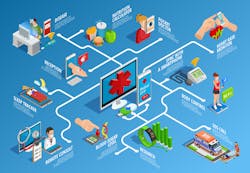Focusing on the accomplishments of accountable care organizations and their capabilities at a time when the COVID-19 pandemic has been severely disrupting the intended shift from the volume-based payment system to the intended value-based payment system, the Washington, D.C.-based National Association of ACOs (NAACOS) on Monday, May 4, posted a press release on the subject to its website.
As NAACOS noted in the press release, “Despite the tremendous adversity facing our health system, population-focused organizations, like accountable care organizations (ACOs), are uniquely positioned in crisis like this because of their years of work supporting care coordination and building an infrastructure to support their ACO work. ACOs across America are identifying vulnerable patients at high-risk for COVID-19 using their population management tools, educating patients about minimizing exposure, making sure they have enough food and medication to stay home, remotely monitoring their underlying conditions, treating cases through telemedicine, and managing post-discharge complications with integrated home health and effective relationships with post-acute providers.”
And, posted to its website, NAACOS shared a variety of case studies and examples of the advantages that ACOs bring t the healthcare system, at a time when the search for value has become challenging. The association, which represents x, shared this information in the form of a PDF on its site.
As the association notes in its document, “ACOs use the same predictive modeling that identifies high-risk patients — such as those who suffer from diabetes or heart disease — to track vulnerable patients during the pandemic. ACO care managers at Coastal Carolina Quality Care ACO in New Bern, N.C. are then reaching out to patients, especially those with mental health conditions, to answer questions, check on medications and general wellbeing, ensure patients have food, and screen for COVID-19 symptoms.”
What’s more, NAACOS notes, “ACOs have quickly pivoted to widely deploy telehealth to maintain patient relationships. At Summit Medical Group in New Jersey, all patients discharged from the hospital are contacted by a care manager and scheduled for a telemedicine visit within 48 hours, with clinicians and patients jointly mapping out a follow-up plan based on illness severity.”
Further, “Since a great deal of ACO success lies in managing patients’ transitions from the hospital, to post-acute care, to the home, ACOs have leveraged their expertise in handling these “handoffs.” Advocate Aurora Health, who operates three ACOs in Wisconsin and Illinois, launched two new programs in five weeks—Home Hospital and Recovery at Home. Patients in both programs receive in-person and virtual home visits from advanced practice clinicians and nurses. Home hospital patients receive oxygen and devices to allow for remote patient monitoring and live video visits, while Recovery at Home patients receive a pulse oximeter for reporting vitals.”
Importantly, NAACOS notes, “As the COVID-19 pandemic draws on, it’s important to highlight how leaders in our health system are proactively working to keep patients safe and healthy in their efforts to limit the spread and impact of coronavirus. This is true for those with and without COVID-19. Policymakers have worked for almost a decade to change incentives in our health system to encourage keeping patients healthy. Those policies are bearing fruit today as provider organizations have built a technology and workforce infrastructure that make them well positioned to care for all their patients, healthy and sick, across all their payers.”
For one thing, there’s the pure volume involved. “Medicare ACO programs now care for roughly a fifth of all Medicare beneficiaries, almost a third without Medicare Advantage, and encompass nearly 500,000 clinicians,” NAACOS notes. “There are more than 550 ACOs in the Shared Savings Program and Next Generation ACO Model. Comparing ACO spending to the absence of ACOs found this important Medicare program lowered Medicare spending by $3.53 billion from 2013 to 2017 and saved $755 million after paying shared savings.”
NAACOS pointed to two case studies in particular, involving Mount Sinai Health System in New York City and Advocate Aurora Health in Aurora, Illinois. The association noted that, “Too often, health care delivery is fragmented and siloed. Health plans and other payers, for example, might have information about emergency department visits and hospitalizations but lack trusted relationships with patients, limiting opportunities to improve care. On the flip side, providers often have strong patient relationships but lack information about care in other settings, missing opportunities to improve outcomes. The ACO model helps bridge this gap by getting providers data they can use to leverage strong patient relationships and improve care.”
The association noted that the Mount Sinai ACO’s leaders used their population health-based capabilities to quickly identify those patients at high risk both for COVID-19 and for chronic conditions that need to be managed at a time of particular medical risk. Similarly, Advocate Aurora Health (AAH), which operates three ACOs across Illinois and Wisconsin, “quickly established a surveillance system an COVID-19 patient registry linked to patients’ electronic health records. Care management teams then monitor patients and provide virtual visits, as well as patient education and information on social resources.”
As NAACOS noted in its press release, “Faced with the greatest public health threat in a century, ACOs across America are identifying patients at high risk for COVID-19, educating them about minimizing exposure, making sure they have enough food and medication to stay home, and remotely monitoring their underlying conditions.” And, it noted, “In response to the COVID-19 pandemic, ACOs are using high-tech, high-touch population health strategies that leverage in-depth information with trusted relationships to support high-risk patients.”
As noted on its website, NAACOS “is a 501 (c) 6 non-profit organization that allows Accountable Care Organizations (ACOs) to work together to increase quality of care, lower costs and improve the health of their communities. Determined to create an environment for advocacy and shared learning, hundreds of ACOs with millions of lives from all 50 states and the District of Columbia formed NAACOS.”


